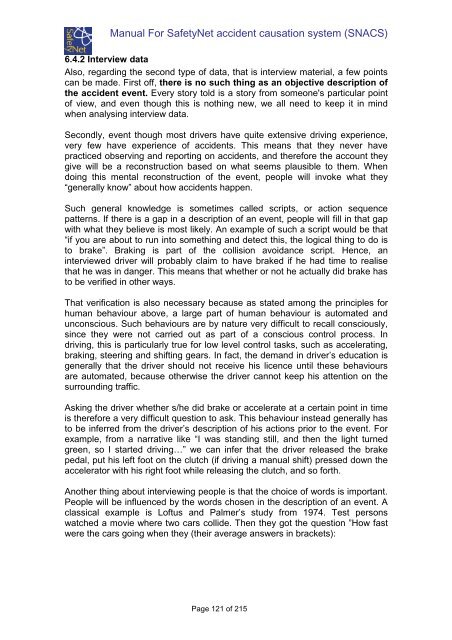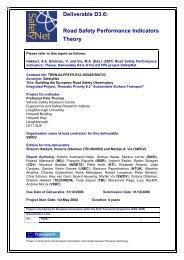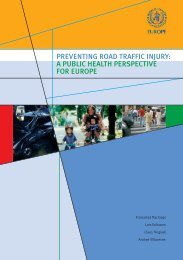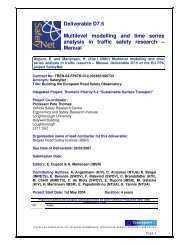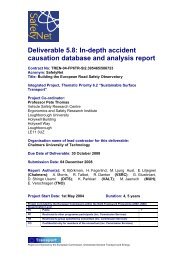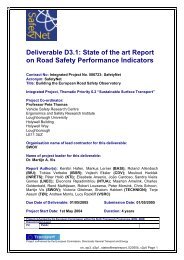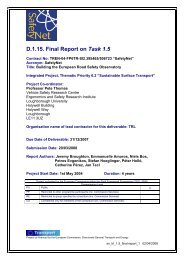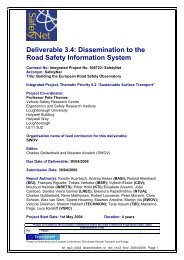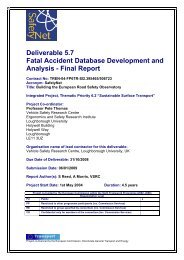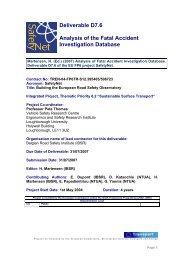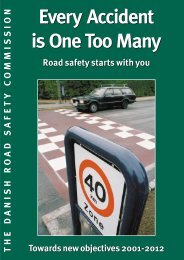Glossary of Data Variables for Fatal and accident causation ... - ERSO
Glossary of Data Variables for Fatal and accident causation ... - ERSO
Glossary of Data Variables for Fatal and accident causation ... - ERSO
Create successful ePaper yourself
Turn your PDF publications into a flip-book with our unique Google optimized e-Paper software.
Manual For SafetyNet <strong>accident</strong> <strong>causation</strong> system (SNACS)<br />
6.4.2 Interview data<br />
Also, regarding the second type <strong>of</strong> data, that is interview material, a few points<br />
can be made. First <strong>of</strong>f, there is no such thing as an objective description <strong>of</strong><br />
the <strong>accident</strong> event. Every story told is a story from someone's particular point<br />
<strong>of</strong> view, <strong>and</strong> even though this is nothing new, we all need to keep it in mind<br />
when analysing interview data.<br />
Secondly, event though most drivers have quite extensive driving experience,<br />
very few have experience <strong>of</strong> <strong>accident</strong>s. This means that they never have<br />
practiced observing <strong>and</strong> reporting on <strong>accident</strong>s, <strong>and</strong> there<strong>for</strong>e the account they<br />
give will be a reconstruction based on what seems plausible to them. When<br />
doing this mental reconstruction <strong>of</strong> the event, people will invoke what they<br />
“generally know” about how <strong>accident</strong>s happen.<br />
Such general knowledge is sometimes called scripts, or action sequence<br />
patterns. If there is a gap in a description <strong>of</strong> an event, people will fill in that gap<br />
with what they believe is most likely. An example <strong>of</strong> such a script would be that<br />
“if you are about to run into something <strong>and</strong> detect this, the logical thing to do is<br />
to brake”. Braking is part <strong>of</strong> the collision avoidance script. Hence, an<br />
interviewed driver will probably claim to have braked if he had time to realise<br />
that he was in danger. This means that whether or not he actually did brake has<br />
to be verified in other ways.<br />
That verification is also necessary because as stated among the principles <strong>for</strong><br />
human behaviour above, a large part <strong>of</strong> human behaviour is automated <strong>and</strong><br />
unconscious. Such behaviours are by nature very difficult to recall consciously,<br />
since they were not carried out as part <strong>of</strong> a conscious control process. In<br />
driving, this is particularly true <strong>for</strong> low level control tasks, such as accelerating,<br />
braking, steering <strong>and</strong> shifting gears. In fact, the dem<strong>and</strong> in driver’s education is<br />
generally that the driver should not receive his licence until these behaviours<br />
are automated, because otherwise the driver cannot keep his attention on the<br />
surrounding traffic.<br />
Asking the driver whether s/he did brake or accelerate at a certain point in time<br />
is there<strong>for</strong>e a very difficult question to ask. This behaviour instead generally has<br />
to be inferred from the driver’s description <strong>of</strong> his actions prior to the event. For<br />
example, from a narrative like “I was st<strong>and</strong>ing still, <strong>and</strong> then the light turned<br />
green, so I started driving…” we can infer that the driver released the brake<br />
pedal, put his left foot on the clutch (if driving a manual shift) pressed down the<br />
accelerator with his right foot while releasing the clutch, <strong>and</strong> so <strong>for</strong>th.<br />
Another thing about interviewing people is that the choice <strong>of</strong> words is important.<br />
People will be influenced by the words chosen in the description <strong>of</strong> an event. A<br />
classical example is L<strong>of</strong>tus <strong>and</strong> Palmer’s study from 1974. Test persons<br />
watched a movie where two cars collide. Then they got the question ”How fast<br />
were the cars going when they (their average answers in brackets):<br />
Page 121 <strong>of</strong> 215


